【人教新版七上英语情境课堂课件含音视频】Starter Unit 1 Hello! Section A
文档属性
| 名称 | 【人教新版七上英语情境课堂课件含音视频】Starter Unit 1 Hello! Section A |  | |
| 格式 | pptx | ||
| 文件大小 | 97.4MB | ||
| 资源类型 | 试卷 | ||
| 版本资源 | 人教版 | ||
| 科目 | 英语 | ||
| 更新时间 | 2025-08-07 00:49:06 | ||
图片预览


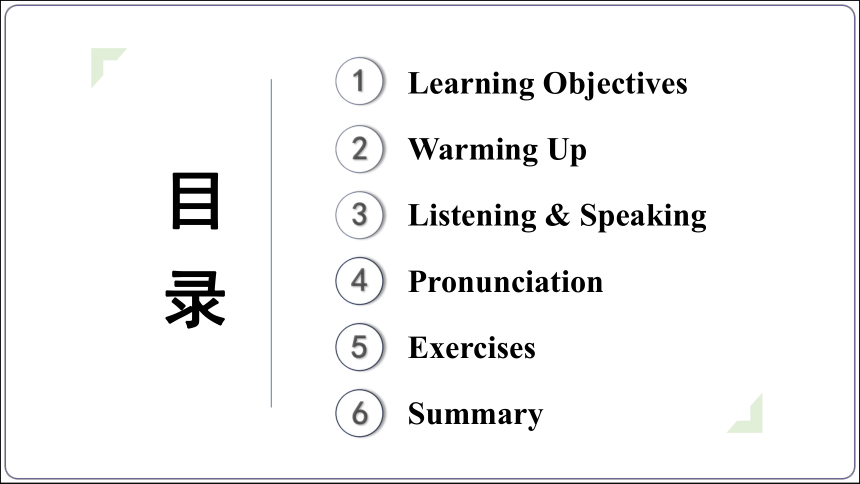
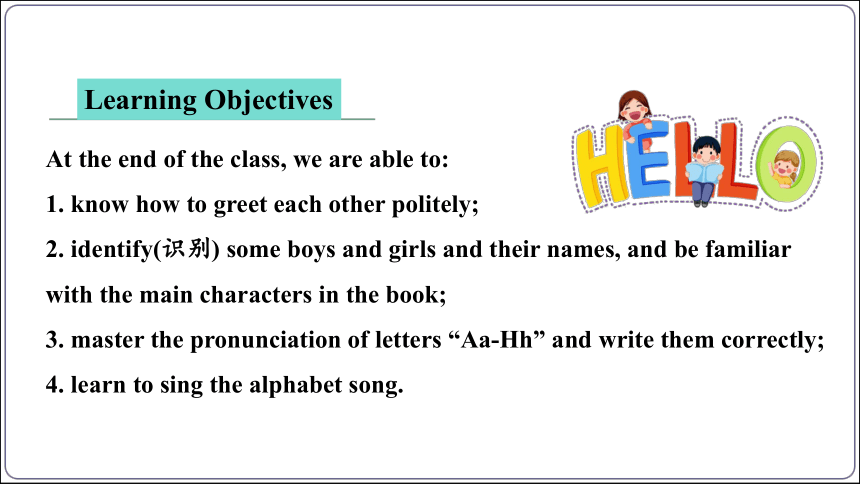


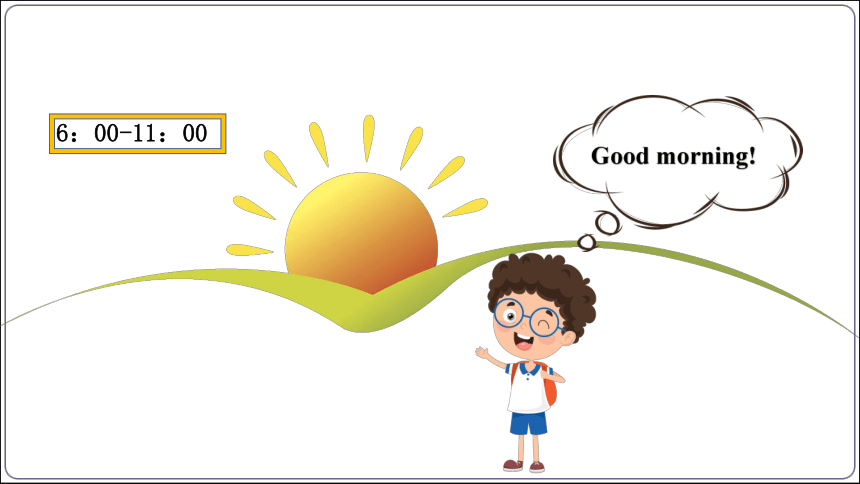
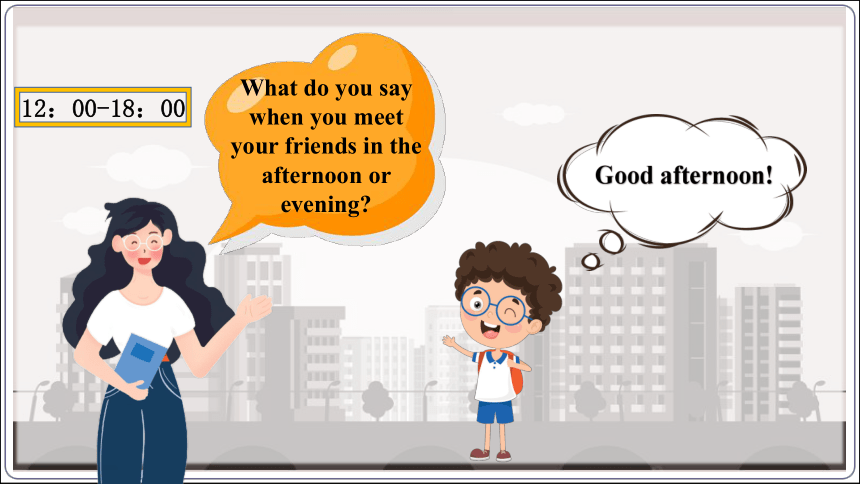

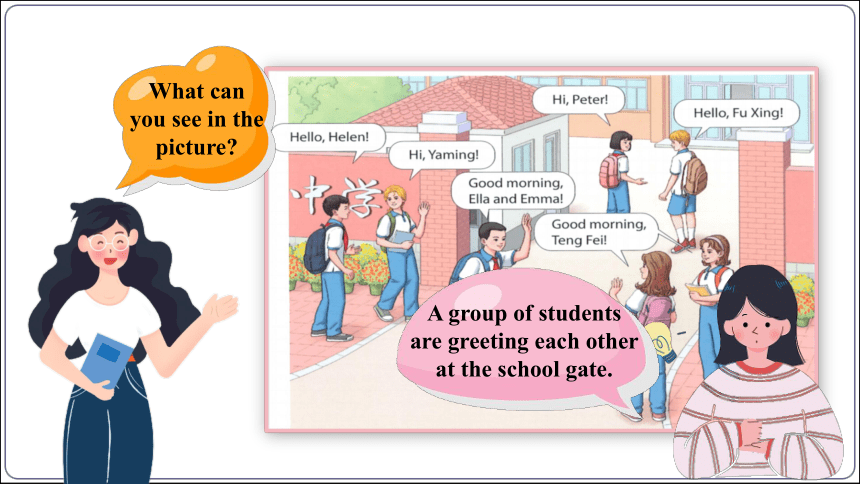
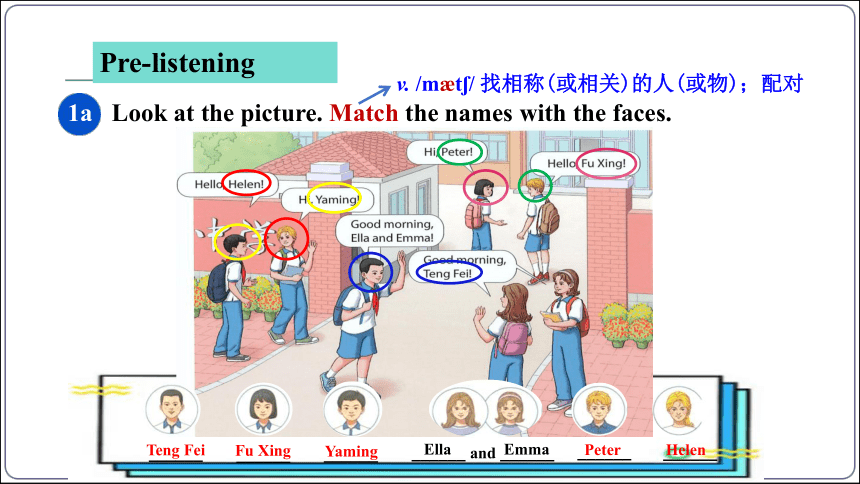
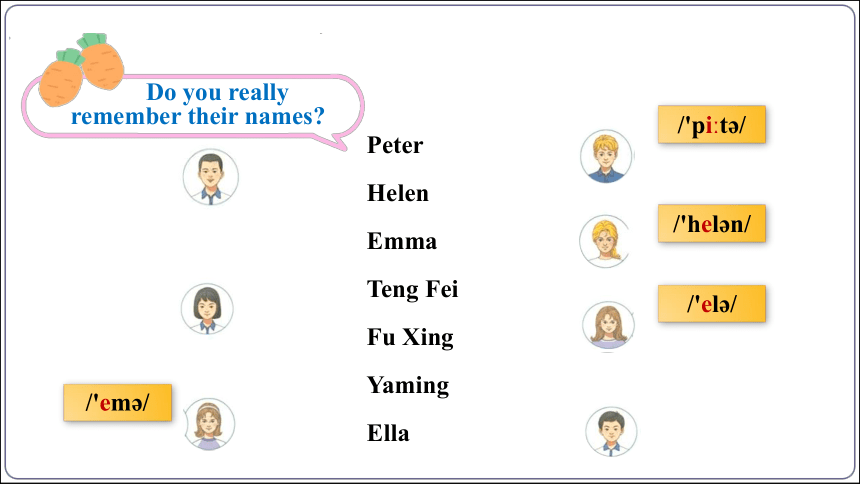
文档简介
(共52张PPT)
人教新版 七上 英语
同步课件
人教新版七上英语情境课堂教学课件(内嵌音视频)
Starter Unit 1 Hello!
Section A How do you greet people
目 录
Warming Up
2
Listening & Speaking
3
Pronunciation
4
Learning Objectives
1
Exercises
5
Summary
6
Learning Objectives
At the end of the class, we are able to:
1. know how to greet each other politely;
2. identify(识别) some boys and girls and their names, and be familiar with the main characters in the book;
3. master the pronunciation of letters “Aa-Hh” and write them correctly;
4. learn to sing the alphabet song.
Warming Up
Let’s enjoy a video and tell us what it is about
点击播放视频
It’s about how to greet each other.
v. /gri:t/
招呼,问候
Great! And what do you say when you meet your friends in the morning
6:00-11:00
Good morning!
12:00-18:00
Good afternoon!
What do you say when you meet your friends in the afternoon or evening
19:00-23:00
Good evening!
Here are some new friends, let’s get to know them!
What can you see in the picture
A group of students
are greeting each other at the school gate.
1a Look at the picture. Match the names with the faces.
Pre-listening
______
______
______
______
______
______ and ______
Ella Emma
Teng Fei
Fu Xing
Yaming
Peter
Helen
v. /m t / 找相称(或相关)的人(或物);配对
/'pi t /
/'hel n/
/'el /
/'em /
Do you really remember their names
Ella
Teng Fei
Fu Xing
Yaming
Peter
Helen
Emma
They are the main characters of this book, and you need to identify(辨别) them!
______
______
______
______
______
______ and ______
Ella Emma
Teng Fei
Fu Xing
Yaming
Peter
Helen
Let's classify(分类) the names.
Chinese Name
English Name
Do you know the difference between Chinese and English names
Culture tips: The difference between Chinese and English names
【中文名】由两部分构成——姓和名
eg:Wang Yaming Chen Jie
中文名用汉语拼音拼写,姓和名要分开写,开头字母大写。
【英文名】英语名与中文名的顺序相反,名在前,姓在后。eg:
full name James Alan Green
First name Middle name Last name
Given name Family name/surname
Circle the greetings.
Hello, Fu Xing.
Hi,Teng Fei.
Good morning, Peter.
Good morning, Helen.
1b Greet your classmates.
Greetings (问候语)
“Hello” or “Hi” are the most common words that people use to greet each other.
People can also refer to the time of
day by saying “Good morning /
afternoon / evening.”
Culture Note
While-listening
2a Listen and say the letters. Then practise writing them.
2b Listen and circle the letters you hear in 2a.
Watch the video to learn how to write 26 letters.
注意在四线三格中字母书写的占格(place)及笔画顺序(order)。
点击播放视频
Where are they
They are in the classroom.
What are they doing
The teacher and students may be introducing themselves to each other.
2c Listen to three conversations. Fill in the blanks with the correct sentences in the box.
1. Ms Gao:Good morning, class.
Class: ________
Ms Gao:Sit down, please.
2. Ms Gao: Hello, Peter. Can you say hi to the class
Peter:________ I’m Peter Brown.
Ms Gao:Thank you, Peter. Now class, please say hi to each other.
D
A
A. Hi, everyone!
B. So what’s your name
C. Nice to meet you, Fu Xing!
D. Good morning, Ms Gao.
pron. / evriw n/
每人;所有人
3. Emma: Good morning. My name is Emma.
Fu Xing: Good morning, Emma.
Emma: __________
Fu Xing: Oh, I’m Fu Xing. Nice to meet you, Emma.
Emma:__________
B
C
A. Hi, everyone!
B. So what’s your name
C. Nice to meet you, Fu Xing!
D. Good morning, Ms Gao.
1. When does Conversation 1 happen
It happens in the morning, because Ms.
Gao greets the class with “Good morning.”
2. Is Peter new in this class
Yes, Peter is new in the class, because Ms.
Gao asks him to introduce himself and
greet the class.
Listen to three conversations again and answer the following questions.
Pay attention to keywords.
3. What does Ms. Gao ask Peter to do
Ms. Gao asks Peter to say hi to the class.
4. How does Peter greet his classmates What does he say
Peter greets his classmates by saying, “Hi, everyone! I’m Peter Brown.”
5. Does Emma know Fu Xing How do you know
No, Emma does not know Fu Xing. She asks him,
“So what’s your name ” and introduces herself with
“My name is Emma.”.
Conversation 1
Ms Gao: Good morning①, class.
Class: Good morning, Ms Gao.
Ms Gao: Sit down, please.
Conversation 2
Ms Gao: Hello, Peter. Can you say hi to the class
Peter: Hi, everyone! I’m Peter Brown.
Ms Gao: Thank you, Peter, Now class,
please say hi to each other.
Click to learn more!
“Ms”(/m z/ or /m z/) is used for women when we don’t know if they are married.
Listen for the tone and learn some key sentences.
Conversation 3
Emma: Good morning. My name is Emma.
Fu Xing: Good morning, Emma.
Emma: So what’s your name②
Fu Xing: Oh, I’m Fu Xing. Nice to meet you, Emma.
Emma: Nice to meet you too, Fu Xing!
Read in groups and think.
Conversation 1
Ms Gao: Good morning, class.
Class: Good morning, Ms Gao.
Ms Gao: Sit down, please.
Conversation 2
Ms Gao: Hello, Peter. Can you say hi to the class
Peter: Hi, everyone! I’m Peter Brown.
Ms Gao: Thank you, Peter, Now class, please say hi to each other.
Conversation 3
Emma: Good morning. My name is Emma.
Fu Xing: Good morning, Emma.
Emma: So what’s your name
Fu Xing: Oh, I’m Fu Xing. Nice to meet you, Emma.
Emma: Nice to meet you too, Fu Xing!
Greeting / Question Response
Good morning, ...!
Hello, ...!
Н , ...!
What's your name
Nice to meet you, ...
Good morning, ...!
Н , ... / Hello, ...!
Н , ...
My name is... / I'm...
Nice to meet you too!
2d Make up a conversation to greet each other.
Post-listening
Good morning. My name is Sally.
I’m Ben. Nice to meet you.
So what’s your name
Hi, Sally.
Nice to meet you too, Ben.
Pronunciation
1 Listen to the 26 letters. Find them on the keyboard. Then
practise with a partner.
A is here.
Where is A
Where is Shift
Shift is here.
Where is B
B is here.
Where is...
... is here.
2 Listen and repeat the letters.
1. /e / A a H h J j K k
2. /i / B b C c D d E e G g P p T t V v Z z
3. /e/ Ff Ll Mm N n S s X x Z z
4. /a / I i Y y
5. / / Oo
6. /ju / Qq Uu Ww
7. /ɑ / Rr
3 Listen to these letters. Match them with the pictures.
1. PRC ______
2. PLA ______
3. VR ______
4. WHO ______
5. UN __________
A
B
E
C
D
abbr. /'pi el'e / 中国人民解放军
abbr. /'vi 'a (r)/ 虚拟现实
abbr. /'pi a (r)si / 中华人民共和国
abbr. /'ju 'en/ 联合国
abbr. / d blju e t / 世界卫生组织
02
PLA (People’s Liberation Army of China) 中国人民解放军
(简称:人民解放军、解放军)
03
VR (Virtual Reality)
虚拟现实
01
PRC(the People’s Republic of China)
中华人民共和国(简称:中国)
Guess the abbreviations (缩略词) by looking at the pictures.
04
05
WHO (World Health Organization)
世界卫生组织
UN (United Nation)
联合国
● Countries: US or USA(United States of America), UK(United Kingdom)
● Days or months: Mon (Monday), Dec (December)
● Personal Titles: Mr(Mister), Dr(Doctor)
● Units: cm(centimetres), m(metres), kg(kilograms)
● Time: a.m. (morning), p.m. (afternoon/evening)
● Online: LOL(laugh out loud), BRB (be right back), ASAP(as soon as possible), IDK(I don’t know)
● Organizations: CCTV(China Central TV), WTO (World Trade Organization)
Common Abbreviations and Acronyms
(常见缩写和首字母缩略词)
4 Listen and sing the song.
A, B, C, D, E, F, G,
H, I, J, K, L, M, N,
O, P, Q, R, S, T,
U, V, W, X, Y, Z.
X, Y, Z—now you see,
I can say my ABCs.
点击播放视频
1. Good morning, class.
(1) good “好的;善良的”,常用来指人的品行好或物品的质地好;还可在问好、打招呼时使用。
fine “健康的;美好的”,可用作表语或定语;也可单独使用。常用来指身体好或天气好。
1. My watch is very _________.
2. —How are you
—I’m _________, thanks.
Language Points
good fine
good
fine
(2) Good morning:“早上好”用于0点~12点这段时间,是较为正式的问候语。它的答语仍为Good morning!
(3) Good morning / afternoon/ evening. 早上/ 下午/ 晚上好。 三者都是正式的问候语。其答语分别是 Good morning / afternoon/ evening. 如果说话的双方比较熟悉,答语也可以直接说“Morning / Afternoon / Evening. ”。
—__________ _________(早上好), Alice.
—_________ _________. / __________ (早上好).
Good morning
Good morning Morning
(1) Hey, Hey man,或者Hi
在年轻人中,Ta们更倾向于用hey和 hi 。hi适用于任何非正式场合,hey适用于已经见过面的。
(2) How’s it going or How are you doing
在非正式场合,如果你想礼貌一些的话,可以用how are you 也可以直接用How’s it going 或者 How are you doing 可使用Good, It’s going well 或者 I’m doing well.回答。
(3) What’s up , What’s new , 或者What’s going on
这些主要用于已经见过面的人,大多数的会回答 nothing或者not much.
【拓展】
返回
2. So what’s your name
(1) What’s one’s name
某人叫什么名字?
该句型用来询问他人姓名,表示“某人叫什么名字?”what’s=what is 。
询问他人姓名 What’s one’s name
回答 ①My/ His/ Her/ Its name’s…
② I’m/ He’s/She’s/ It’s…
③直接回答出名字。
(2)name “名称,名字”常用于形容词性物主代词(my/your/his/her)或名词所有格后
Lisa,你知道那个女孩/她的名字吗
—Lisa, do you know _______________ _________
知道,她是我的姐姐 Lily。
—Yes, _______________ _________ is Lily.
her/the girl’s name
her/the girl’s name
(3)full name 全名 ;
first name 名(=given name);
last name 姓(= family name)
I am Gina. My last name is Smith.
我是 Gina。 我的姓是 Smith。
Gina Smith
first name
=given name(名)
last name
= family name(姓)
拓展
(1)英语中其他常见的询问对方名字的句型:
①What’s your name, please ② May / Can I have your name, please ③Can you tell me your name
(2)英文姓名和中文姓名的写法不同:英文姓名 = 名字+姓氏;这与中国人的姓名顺序相反。
中文姓名: Yang Liwei(姓氏+名字) 英文姓名: Bill Gates(名字+姓氏)
(3)在正式场合中,英美国家的人称呼对方时,往往在姓氏前面加上 “Mr. (先生),Miss(小姐),Mrs. (夫人),Ms. (女士)”以示尊重。
返回
Exercises
1. 以下哪个字母和Gg一样含有同样的元音/i:/ ______
A. Aa B. Bb C. Hh
2. 早上见到朋友了, 你会对他说: ______。
A. Good morning. B. Good afternoon. C. Good evening.
一、单项选择。
B
A
3. — What’s your name —______.
A. He is Dale. B. My name is Linda.
C. She is my friend. D. You, too.
4. —Can you teach me how to _____ “morning”, please, David
— It’s M-O-R-N-I-N-G.
A. speak B. spell C. see
B
B
二、根据所给句子意思,将打乱的字母组合成单词,再将单词填入相应的句子。
1. ________(olehl), Frank!
2. Can you ______(lsepl) it
3. Cindy is a________(odog) girl.
4. Good__________(omringn), my friend!
5. My________(amne) is Alice.
Hello
spell
good
morning
name
1. Topic: Greet people
2. Words and Expressions:
unit, starter, section, greet, spell, good, morning, hi, hello, goodbye, Letters A-H, PLA, VR...
3. Key sentences:
①Good morning, Teng Fei!
②—What’s your name
— My name is Peter Brown.
③ Hi, Peter! Hello, Fu Xing!
④ Goodbye!
Summary
Thanks!
https://www.21cnjy.com/recruitment/home/fine
人教新版 七上 英语
同步课件
人教新版七上英语情境课堂教学课件(内嵌音视频)
Starter Unit 1 Hello!
Section A How do you greet people
目 录
Warming Up
2
Listening & Speaking
3
Pronunciation
4
Learning Objectives
1
Exercises
5
Summary
6
Learning Objectives
At the end of the class, we are able to:
1. know how to greet each other politely;
2. identify(识别) some boys and girls and their names, and be familiar with the main characters in the book;
3. master the pronunciation of letters “Aa-Hh” and write them correctly;
4. learn to sing the alphabet song.
Warming Up
Let’s enjoy a video and tell us what it is about
点击播放视频
It’s about how to greet each other.
v. /gri:t/
招呼,问候
Great! And what do you say when you meet your friends in the morning
6:00-11:00
Good morning!
12:00-18:00
Good afternoon!
What do you say when you meet your friends in the afternoon or evening
19:00-23:00
Good evening!
Here are some new friends, let’s get to know them!
What can you see in the picture
A group of students
are greeting each other at the school gate.
1a Look at the picture. Match the names with the faces.
Pre-listening
______
______
______
______
______
______ and ______
Ella Emma
Teng Fei
Fu Xing
Yaming
Peter
Helen
v. /m t / 找相称(或相关)的人(或物);配对
/'pi t /
/'hel n/
/'el /
/'em /
Do you really remember their names
Ella
Teng Fei
Fu Xing
Yaming
Peter
Helen
Emma
They are the main characters of this book, and you need to identify(辨别) them!
______
______
______
______
______
______ and ______
Ella Emma
Teng Fei
Fu Xing
Yaming
Peter
Helen
Let's classify(分类) the names.
Chinese Name
English Name
Do you know the difference between Chinese and English names
Culture tips: The difference between Chinese and English names
【中文名】由两部分构成——姓和名
eg:Wang Yaming Chen Jie
中文名用汉语拼音拼写,姓和名要分开写,开头字母大写。
【英文名】英语名与中文名的顺序相反,名在前,姓在后。eg:
full name James Alan Green
First name Middle name Last name
Given name Family name/surname
Circle the greetings.
Hello, Fu Xing.
Hi,Teng Fei.
Good morning, Peter.
Good morning, Helen.
1b Greet your classmates.
Greetings (问候语)
“Hello” or “Hi” are the most common words that people use to greet each other.
People can also refer to the time of
day by saying “Good morning /
afternoon / evening.”
Culture Note
While-listening
2a Listen and say the letters. Then practise writing them.
2b Listen and circle the letters you hear in 2a.
Watch the video to learn how to write 26 letters.
注意在四线三格中字母书写的占格(place)及笔画顺序(order)。
点击播放视频
Where are they
They are in the classroom.
What are they doing
The teacher and students may be introducing themselves to each other.
2c Listen to three conversations. Fill in the blanks with the correct sentences in the box.
1. Ms Gao:Good morning, class.
Class: ________
Ms Gao:Sit down, please.
2. Ms Gao: Hello, Peter. Can you say hi to the class
Peter:________ I’m Peter Brown.
Ms Gao:Thank you, Peter. Now class, please say hi to each other.
D
A
A. Hi, everyone!
B. So what’s your name
C. Nice to meet you, Fu Xing!
D. Good morning, Ms Gao.
pron. / evriw n/
每人;所有人
3. Emma: Good morning. My name is Emma.
Fu Xing: Good morning, Emma.
Emma: __________
Fu Xing: Oh, I’m Fu Xing. Nice to meet you, Emma.
Emma:__________
B
C
A. Hi, everyone!
B. So what’s your name
C. Nice to meet you, Fu Xing!
D. Good morning, Ms Gao.
1. When does Conversation 1 happen
It happens in the morning, because Ms.
Gao greets the class with “Good morning.”
2. Is Peter new in this class
Yes, Peter is new in the class, because Ms.
Gao asks him to introduce himself and
greet the class.
Listen to three conversations again and answer the following questions.
Pay attention to keywords.
3. What does Ms. Gao ask Peter to do
Ms. Gao asks Peter to say hi to the class.
4. How does Peter greet his classmates What does he say
Peter greets his classmates by saying, “Hi, everyone! I’m Peter Brown.”
5. Does Emma know Fu Xing How do you know
No, Emma does not know Fu Xing. She asks him,
“So what’s your name ” and introduces herself with
“My name is Emma.”.
Conversation 1
Ms Gao: Good morning①, class.
Class: Good morning, Ms Gao.
Ms Gao: Sit down, please.
Conversation 2
Ms Gao: Hello, Peter. Can you say hi to the class
Peter: Hi, everyone! I’m Peter Brown.
Ms Gao: Thank you, Peter, Now class,
please say hi to each other.
Click to learn more!
“Ms”(/m z/ or /m z/) is used for women when we don’t know if they are married.
Listen for the tone and learn some key sentences.
Conversation 3
Emma: Good morning. My name is Emma.
Fu Xing: Good morning, Emma.
Emma: So what’s your name②
Fu Xing: Oh, I’m Fu Xing. Nice to meet you, Emma.
Emma: Nice to meet you too, Fu Xing!
Read in groups and think.
Conversation 1
Ms Gao: Good morning, class.
Class: Good morning, Ms Gao.
Ms Gao: Sit down, please.
Conversation 2
Ms Gao: Hello, Peter. Can you say hi to the class
Peter: Hi, everyone! I’m Peter Brown.
Ms Gao: Thank you, Peter, Now class, please say hi to each other.
Conversation 3
Emma: Good morning. My name is Emma.
Fu Xing: Good morning, Emma.
Emma: So what’s your name
Fu Xing: Oh, I’m Fu Xing. Nice to meet you, Emma.
Emma: Nice to meet you too, Fu Xing!
Greeting / Question Response
Good morning, ...!
Hello, ...!
Н , ...!
What's your name
Nice to meet you, ...
Good morning, ...!
Н , ... / Hello, ...!
Н , ...
My name is... / I'm...
Nice to meet you too!
2d Make up a conversation to greet each other.
Post-listening
Good morning. My name is Sally.
I’m Ben. Nice to meet you.
So what’s your name
Hi, Sally.
Nice to meet you too, Ben.
Pronunciation
1 Listen to the 26 letters. Find them on the keyboard. Then
practise with a partner.
A is here.
Where is A
Where is Shift
Shift is here.
Where is B
B is here.
Where is...
... is here.
2 Listen and repeat the letters.
1. /e / A a H h J j K k
2. /i / B b C c D d E e G g P p T t V v Z z
3. /e/ Ff Ll Mm N n S s X x Z z
4. /a / I i Y y
5. / / Oo
6. /ju / Qq Uu Ww
7. /ɑ / Rr
3 Listen to these letters. Match them with the pictures.
1. PRC ______
2. PLA ______
3. VR ______
4. WHO ______
5. UN __________
A
B
E
C
D
abbr. /'pi el'e / 中国人民解放军
abbr. /'vi 'a (r)/ 虚拟现实
abbr. /'pi a (r)si / 中华人民共和国
abbr. /'ju 'en/ 联合国
abbr. / d blju e t / 世界卫生组织
02
PLA (People’s Liberation Army of China) 中国人民解放军
(简称:人民解放军、解放军)
03
VR (Virtual Reality)
虚拟现实
01
PRC(the People’s Republic of China)
中华人民共和国(简称:中国)
Guess the abbreviations (缩略词) by looking at the pictures.
04
05
WHO (World Health Organization)
世界卫生组织
UN (United Nation)
联合国
● Countries: US or USA(United States of America), UK(United Kingdom)
● Days or months: Mon (Monday), Dec (December)
● Personal Titles: Mr(Mister), Dr(Doctor)
● Units: cm(centimetres), m(metres), kg(kilograms)
● Time: a.m. (morning), p.m. (afternoon/evening)
● Online: LOL(laugh out loud), BRB (be right back), ASAP(as soon as possible), IDK(I don’t know)
● Organizations: CCTV(China Central TV), WTO (World Trade Organization)
Common Abbreviations and Acronyms
(常见缩写和首字母缩略词)
4 Listen and sing the song.
A, B, C, D, E, F, G,
H, I, J, K, L, M, N,
O, P, Q, R, S, T,
U, V, W, X, Y, Z.
X, Y, Z—now you see,
I can say my ABCs.
点击播放视频
1. Good morning, class.
(1) good “好的;善良的”,常用来指人的品行好或物品的质地好;还可在问好、打招呼时使用。
fine “健康的;美好的”,可用作表语或定语;也可单独使用。常用来指身体好或天气好。
1. My watch is very _________.
2. —How are you
—I’m _________, thanks.
Language Points
good fine
good
fine
(2) Good morning:“早上好”用于0点~12点这段时间,是较为正式的问候语。它的答语仍为Good morning!
(3) Good morning / afternoon/ evening. 早上/ 下午/ 晚上好。 三者都是正式的问候语。其答语分别是 Good morning / afternoon/ evening. 如果说话的双方比较熟悉,答语也可以直接说“Morning / Afternoon / Evening. ”。
—__________ _________(早上好), Alice.
—_________ _________. / __________ (早上好).
Good morning
Good morning Morning
(1) Hey, Hey man,或者Hi
在年轻人中,Ta们更倾向于用hey和 hi 。hi适用于任何非正式场合,hey适用于已经见过面的。
(2) How’s it going or How are you doing
在非正式场合,如果你想礼貌一些的话,可以用how are you 也可以直接用How’s it going 或者 How are you doing 可使用Good, It’s going well 或者 I’m doing well.回答。
(3) What’s up , What’s new , 或者What’s going on
这些主要用于已经见过面的人,大多数的会回答 nothing或者not much.
【拓展】
返回
2. So what’s your name
(1) What’s one’s name
某人叫什么名字?
该句型用来询问他人姓名,表示“某人叫什么名字?”what’s=what is 。
询问他人姓名 What’s one’s name
回答 ①My/ His/ Her/ Its name’s…
② I’m/ He’s/She’s/ It’s…
③直接回答出名字。
(2)name “名称,名字”常用于形容词性物主代词(my/your/his/her)或名词所有格后
Lisa,你知道那个女孩/她的名字吗
—Lisa, do you know _______________ _________
知道,她是我的姐姐 Lily。
—Yes, _______________ _________ is Lily.
her/the girl’s name
her/the girl’s name
(3)full name 全名 ;
first name 名(=given name);
last name 姓(= family name)
I am Gina. My last name is Smith.
我是 Gina。 我的姓是 Smith。
Gina Smith
first name
=given name(名)
last name
= family name(姓)
拓展
(1)英语中其他常见的询问对方名字的句型:
①What’s your name, please ② May / Can I have your name, please ③Can you tell me your name
(2)英文姓名和中文姓名的写法不同:英文姓名 = 名字+姓氏;这与中国人的姓名顺序相反。
中文姓名: Yang Liwei(姓氏+名字) 英文姓名: Bill Gates(名字+姓氏)
(3)在正式场合中,英美国家的人称呼对方时,往往在姓氏前面加上 “Mr. (先生),Miss(小姐),Mrs. (夫人),Ms. (女士)”以示尊重。
返回
Exercises
1. 以下哪个字母和Gg一样含有同样的元音/i:/ ______
A. Aa B. Bb C. Hh
2. 早上见到朋友了, 你会对他说: ______。
A. Good morning. B. Good afternoon. C. Good evening.
一、单项选择。
B
A
3. — What’s your name —______.
A. He is Dale. B. My name is Linda.
C. She is my friend. D. You, too.
4. —Can you teach me how to _____ “morning”, please, David
— It’s M-O-R-N-I-N-G.
A. speak B. spell C. see
B
B
二、根据所给句子意思,将打乱的字母组合成单词,再将单词填入相应的句子。
1. ________(olehl), Frank!
2. Can you ______(lsepl) it
3. Cindy is a________(odog) girl.
4. Good__________(omringn), my friend!
5. My________(amne) is Alice.
Hello
spell
good
morning
name
1. Topic: Greet people
2. Words and Expressions:
unit, starter, section, greet, spell, good, morning, hi, hello, goodbye, Letters A-H, PLA, VR...
3. Key sentences:
①Good morning, Teng Fei!
②—What’s your name
— My name is Peter Brown.
③ Hi, Peter! Hello, Fu Xing!
④ Goodbye!
Summary
Thanks!
https://www.21cnjy.com/recruitment/home/fine
同课章节目录
